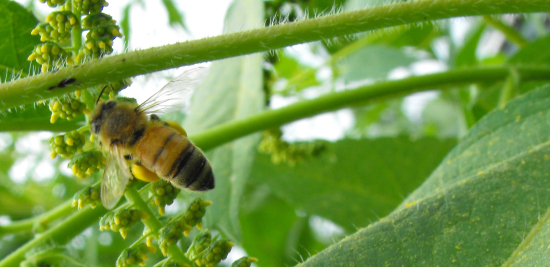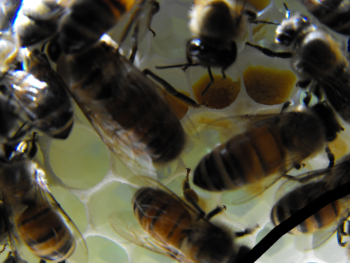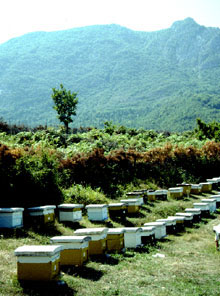
Bee hive density and pollen diversity
 The
final eye-opener in The
Bee-friendly Beekeeper
wasn't specific to Warre hives at all. Instead,
Heaf's information about the optimal environment for apiaries is
relevant to any kind of beekeeping.
The
final eye-opener in The
Bee-friendly Beekeeper
wasn't specific to Warre hives at all. Instead,
Heaf's information about the optimal environment for apiaries is
relevant to any kind of beekeeping.
Most beekeepers, like
me, tend to think that as long as bees have plenty of flowers around,
they're in good shape for food. However, Heaf explained that all
pollen isn't created equal, and that each species' flowers produce
pollen with different amounts and types  of
proteins, fats, vitamins, and minerals. Just like the healthy
homesteader wants to eat several types of vegetables rather than
relying on carrots alone, the healthy bee needs a diversity of pollen
sources to round out its diet. Scientists have found that bees
forced to subsist on only one or a few types of pollen tend to get sick
more often, presumably because they're malnourished. So, don't
just plant fields of white clover or buckwheat for your bees --- work
to diversify the wild and cultivated landscape to keep your hives
healthy.
of
proteins, fats, vitamins, and minerals. Just like the healthy
homesteader wants to eat several types of vegetables rather than
relying on carrots alone, the healthy bee needs a diversity of pollen
sources to round out its diet. Scientists have found that bees
forced to subsist on only one or a few types of pollen tend to get sick
more often, presumably because they're malnourished. So, don't
just plant fields of white clover or buckwheat for your bees --- work
to diversify the wild and cultivated landscape to keep your hives
healthy.
The other interesting
environmental issue relates to cramming bees together into
apiaries. A variety of scientific studies have shown that feral
honeybees spread their homes out across the landscape, both so they
don't compete with other hives for forage and also so they don't give
each other diseases. In areas like Australia where varroa mites
are absent  and other parasites and
diseases are rare, honeybees may live as close together as 197 colonies
per square mile (or 3 acres apiece). However, problematic areas
in the U.S. with high varroa mite counts have been found to support
only 3 feral colonies per square mile.
and other parasites and
diseases are rare, honeybees may live as close together as 197 colonies
per square mile (or 3 acres apiece). However, problematic areas
in the U.S. with high varroa mite counts have been found to support
only 3 feral colonies per square mile.
The middle ground seems
to be providing around 21 to 35 acres per colony of honeybees (a
density of 18 to 31 colonies per square mile). When you're
looking at your bee density, you should take your neighbors into
consideration, figuring that bees avidly forage within about a mile of
their home and do 95% of their hunting within the inner 3.7
miles. So, if you only own an acre, but know there are no other
honeybees within four miles, you can have a lot more hives in your
apiary without undue crowding than if you owned 50 acres but were
surrounded by beekeepers on every side. You might also consider
spreading your hives out across whatever land you do have rather than
keeping them close together in an apiary situation.
| This post is part of our Warre Hive lunchtime series.
Read all of the entries: |
Want more in-depth information? Browse through our books.
Or explore more posts by date or by subject.
About us: Anna Hess and Mark Hamilton spent over a decade living self-sufficiently in the mountains of Virginia before moving north to start over from scratch in the foothills of Ohio. They've experimented with permaculture, no-till gardening, trailersteading, home-based microbusinesses and much more, writing about their adventures in both blogs and books.
Want to be notified when new comments are posted on this page? Click on the RSS button after you add a comment to subscribe to the comment feed, or simply check the box beside "email replies to me" while writing your comment.
